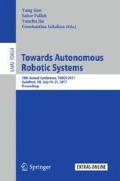Abstract
Biological tissues are complex structures with changing mechanical properties depending on physiological or pathological factors. Thus they are extendible under normal conditions or stiff if they are subject to an inflammatory reaction. We design and fabricate a low-power and low-cost stiffness-variable tissue phantom (SVTP) that can extend up to 250% and contract up to 5.4% at 5 V (1.4 W), mimicking properties of biological tissues. We investigated the mechanical characteristics of SVTP in simulation and experiment. We also demonstrate its potential by building an oesophagus phantom for testing appropriate force controls in a robotic implant that is meant to manipulate biological oesophageal tissues with changing stiffness in vivo. The entire platform permits efficient testing of robotic implants in the context of anomalies such as long gap esophageal atresia, and could potentially serve as a replacement for live animal tissues.
A. Thorn and D. Afacan—Contributed equally.
Access this chapter
Tax calculation will be finalised at checkout
Purchases are for personal use only
References
Afacan, D.: Stiffness-adaptive control of tissue manipulation using a robotic implant. Master’s thesis, University of Sheffield, Sheffield, UK (2016)
Balapgol, B.S., Kulkarni, S.A., Bajoria, K.M.: A review on shape memory alloy structures. Int. J. Acoust. Vibr. 9(2), 61–68 (2004)
Bergeles, C., Guang-Zhong, Y.: From passive tool holders to microsurgeons: safer, smaller, smarter surgical robots. IEEE Trans. Biomed. Eng. 61(5), 1565–1576 (2014)
Bhatia, S.N., Ingber, D.E.: Microfluidic organs-on-chips. Nat. Biotech. 32, 760–772 (2014)
Caldwell, D.G., Medrano-Cerda, G., Goodwin, M.: Control of pneumatic muscle actuators. IEEE Control Syst. Mag. 15(1), 40–48 (1995)
Cartabuke, R.H., Lopez, R., Thota, P.N.: Long-term esophageal and respiratory outcomes in children with esophageal atresia and tracheoesophageal fistula. Oxford J. Med. Health Gastroenterol. Rep., 1–5 (2015)
Corr, D.T., Hart, D.A.: Biomechanics of scar tissue and uninjured skin. Adv. Wound Care (New Rochelle) 2(2), 37–43 (2013)
Costa, I.F.: A novel deformation method for fast simulation of biological tissue formed by fibers and fluid. Med. Image Anal. 16(5), 1038–1046 (2012)
Damian, D.D., et al.: Robotic implant to apply tissue traction forces in the treatment of esophageal atresia. In: IEEE International Conference on Robotics and Automation (ICRA), pp. 786–792 (2014)
Foker, J.E., et al.: Development of a true primary repair for the full spectrum of esophageal atresia. Ann. Surg. 226(4), 533–543 (1997)
Foker, J.E., et al.: Long-gap esophageal atresia treated by growth induction: the biological potential and early follow-up results. Semin. Pediatr. Surg. 18, 23–29 (2009)
Fries, F., et al.: Electromagnetically driven elastic actuator. In: International Conference on Robotics and Biomimetics, pp. 309–314 (2014)
Goyal, R.K., Chaudhury, A.: Physiology of normal esophageal motility. J. Clin. Gastroenterol. 42(5), 610–619 (2008)
Haines, C., et al.: Artificial muscles from fishing line and sewing thread. Science 343, 868–872 (2014)
Huh, D., Hamilton, G.A., Ingber, D.E.: From three-dimensional cell culture to organs-on-chips. Trends Cell Biol. 21(12), 745–754 (2011)
Jung, K., Kim, K.J., Choi, H.R.: Self-sensing of dielectric elastomer actuator. Sens. Actuators A Phys. 143, 343–351 (2008)
Klute, G.K., Czerniecki, J.M., Hannaford, B.: Mckibben artificial muscles: pneumatic actuators with biomechanical intelligence. In: IEEE/ASME International Conference on Advanced Intelligent Mechatronics, pp. 221–226 (1999)
Kummer, M.P., et al.: OctoMag: an electromagnetic system for 5-DOF wireless micromanipulation. In: IEEE International Conference on Robotics and Automation (ICRA), pp. 1006–1017 (2010)
Laschi, C., et al.: Soft robot arm inspired by the octopus. Adv. Robot. 26(7), 709–727 (2012)
Lendlein, A., Kelch, S.: Shape-memory polymers. Angew. Chem. Int. Ed. 41, 2034–2057 (2002)
Martinez, R.V., et al.: Elastomeric origami: programmable paper-elastomer composites as pneumatic actuators. Adv. Funct. Mater. 22, 1376–1384 (2012)
Misra, S., Ramesh, K., Okamura, A.M.: Modeling of nonlinear elastic tissues for surgical simulation. Comput. Meth. Biomech. Biomed. Eng. 13(6), 811–818 (2010)
Miyashita, S., et al.: Ingestible, controllable, and degradable origami robot for patching stomach wounds. In: IEEE International Conference on Robotics and Automation (ICRA) (2016)
Nelson, B.J., Kaliakatsos, I.K., Abbott, J.J.: Microrobots for minimally invasive medicine. Annu. Rev. Biomed. Eng. 12, 55–85 (2010)
Ogawa, K., Narioka, K., Hosoda, K.: Development of whole-body humanoid “pneumat-BS” with pneumatic musculoskeletal system. In: IEEE/RSJ International Conference on Intelligent Robots and Systems, pp. 4838–4843 (2011)
Palacio-Torralba, J., et al.: Quantitative diagnostics of soft tissue through viscoelastic characterization using time-based instrumented palpation. J. Mech. Behav. Biomed. Mater. 41, 149–160 (2015)
Roche, E.T., et al.: A bioinspired soft actuated material. Adv. Mater. 26(8), 1200–1206 (2014)
Shan, W., et al.: Rigidity-tuning conductive elastomer. Smart Mater. Struct. 24(6), 343–351 (2015)
Umedachi, T., Vikas, V., Trimmer, B.A.: Softworms: the design and control of non-pneumatic, 3D-printed, deformable robots. Bioinspiration Biomimetics 11, 025001 (2016)
Valdastri, P., Simi, M., Webster III, R.J.: Advanced technologies for gastrointestinal endoscopy. Annu. Rev. Biomed. Eng. 14, 397–429 (2012)
Yim, S., Goyal, K., Sitti, M.: Magnetically actuated soft capsule with the multimodal drug relase function. IEEE/ASME Trans. Mechatron. 18(4), 1413–1418 (2013)
Acknowledgment
We thank Emily Southern for her help with the paper revision. This work was supported by the University of Sheffield.
Author information
Authors and Affiliations
Corresponding author
Editor information
Editors and Affiliations
Rights and permissions
Copyright information
© 2017 Springer International Publishing AG
About this paper
Cite this paper
Thorn, A., Afacan, D., Ingham, E., Kavak, C., Miyashita, S., Damian, D.D. (2017). Low-Power and Low-Cost Stiffness-Variable Oesophageal Tissue Phantom. In: Gao, Y., Fallah, S., Jin, Y., Lekakou, C. (eds) Towards Autonomous Robotic Systems. TAROS 2017. Lecture Notes in Computer Science(), vol 10454. Springer, Cham. https://doi.org/10.1007/978-3-319-64107-2_28
Download citation
DOI: https://doi.org/10.1007/978-3-319-64107-2_28
Published:
Publisher Name: Springer, Cham
Print ISBN: 978-3-319-64106-5
Online ISBN: 978-3-319-64107-2
eBook Packages: Computer ScienceComputer Science (R0)

